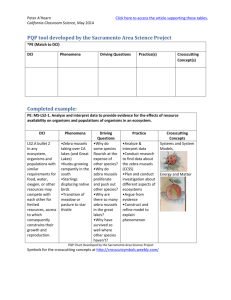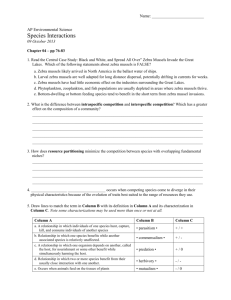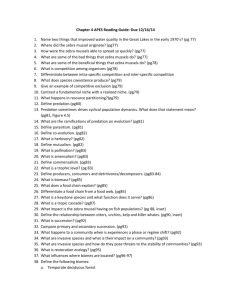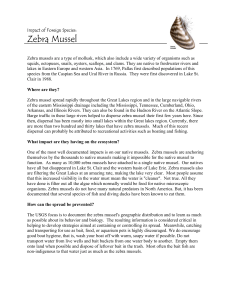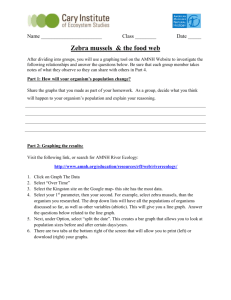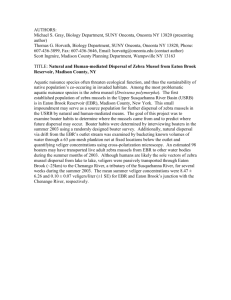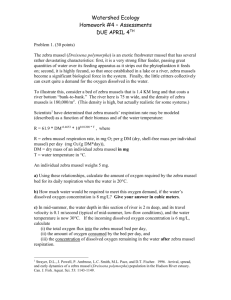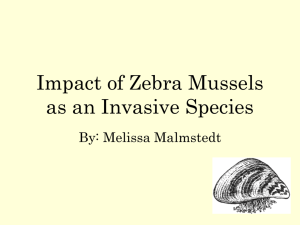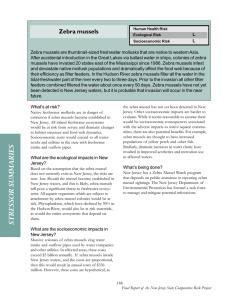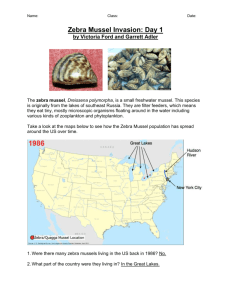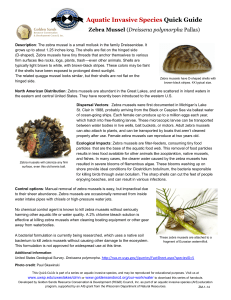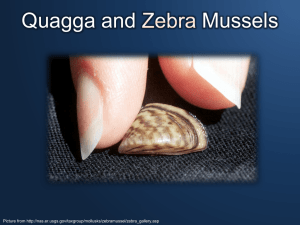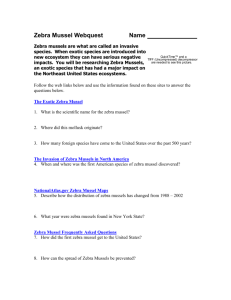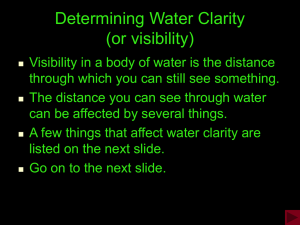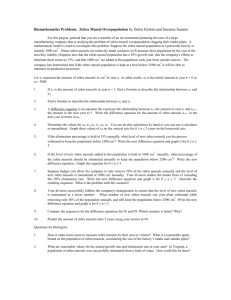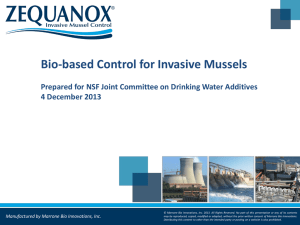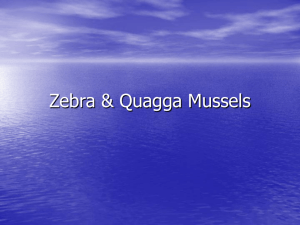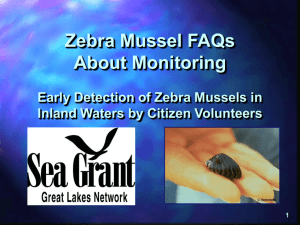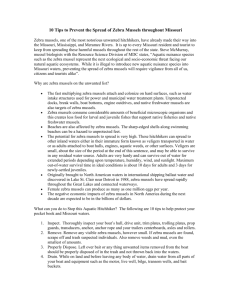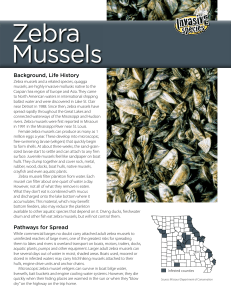3.TL_Zebra__Mussel
advertisement
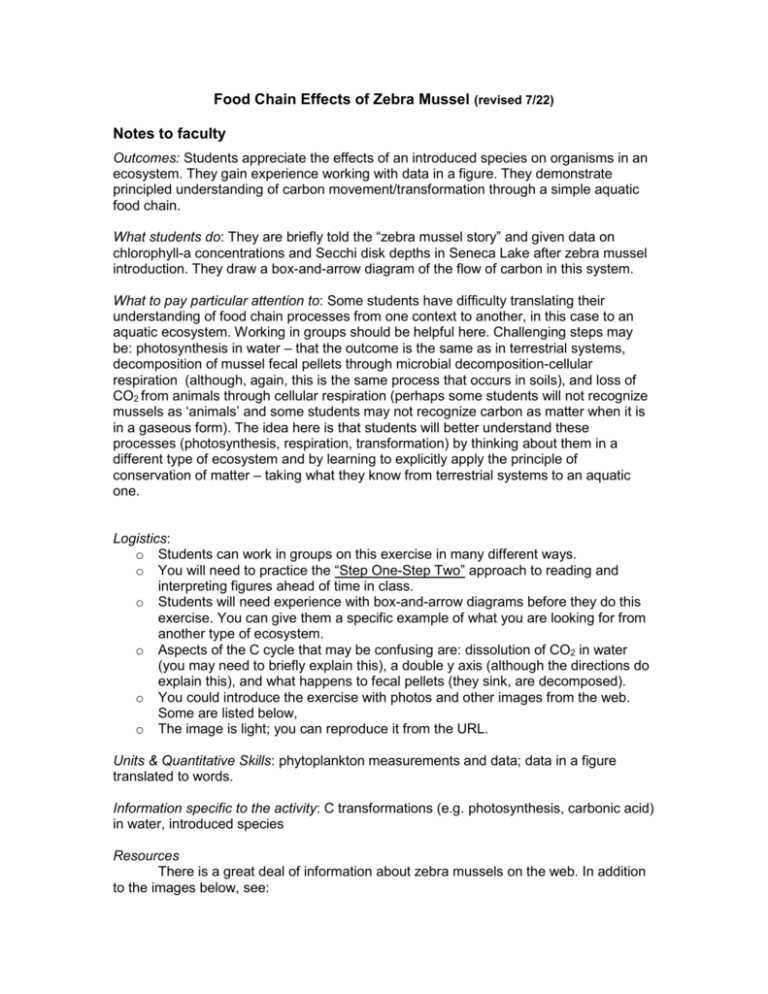
Food Chain Effects of Zebra Mussel (revised 7/22) Notes to faculty Outcomes: Students appreciate the effects of an introduced species on organisms in an ecosystem. They gain experience working with data in a figure. They demonstrate principled understanding of carbon movement/transformation through a simple aquatic food chain. What students do: They are briefly told the “zebra mussel story” and given data on chlorophyll-a concentrations and Secchi disk depths in Seneca Lake after zebra mussel introduction. They draw a box-and-arrow diagram of the flow of carbon in this system. What to pay particular attention to: Some students have difficulty translating their understanding of food chain processes from one context to another, in this case to an aquatic ecosystem. Working in groups should be helpful here. Challenging steps may be: photosynthesis in water – that the outcome is the same as in terrestrial systems, decomposition of mussel fecal pellets through microbial decomposition-cellular respiration (although, again, this is the same process that occurs in soils), and loss of CO2 from animals through cellular respiration (perhaps some students will not recognize mussels as ‘animals’ and some students may not recognize carbon as matter when it is in a gaseous form). The idea here is that students will better understand these processes (photosynthesis, respiration, transformation) by thinking about them in a different type of ecosystem and by learning to explicitly apply the principle of conservation of matter – taking what they know from terrestrial systems to an aquatic one. Logistics: o Students can work in groups on this exercise in many different ways. o You will need to practice the “Step One-Step Two” approach to reading and interpreting figures ahead of time in class. o Students will need experience with box-and-arrow diagrams before they do this exercise. You can give them a specific example of what you are looking for from another type of ecosystem. o Aspects of the C cycle that may be confusing are: dissolution of CO2 in water (you may need to briefly explain this), a double y axis (although the directions do explain this), and what happens to fecal pellets (they sink, are decomposed). o You could introduce the exercise with photos and other images from the web. Some are listed below, o The image is light; you can reproduce it from the URL. Units & Quantitative Skills: phytoplankton measurements and data; data in a figure translated to words. Information specific to the activity: C transformations (e.g. photosynthesis, carbonic acid) in water, introduced species Resources There is a great deal of information about zebra mussels on the web. In addition to the images below, see: o o o o USDA (http://www.invasivespeciesinfo.gov/aquatics/zebramussel.shtml) National Atlas (http://www.nationalatlas.gov/articles/biology/a_zm.html) Gulf States Fish. Com. (http://nis.gsmfc.org/nis_factsheet.php?toc_id=131) TIEE (http://tiee.ecoed.net/vol/v1/figure_sets/species/species_figs.html) HIDDEN CURRICULUM ADDRESSED • Principles: Conservation of Matter (assimilation of carbon by producers, transfer of carbon from producers to consumers, transfer of carbon from producers/consumers to decomposers, transfer of carbon to atmosphere during respiration by all organisms in the food chain) Processes: Generation (photosynthesis); Transformation (building of biomolecules within an organism, consumption of one organism by another); Oxidation (autotrophic respiration, heterotrophic respiration, decomposition) • Scale & Time: Processes across atomic/molecular-organismal-ecosystem scales. • Forms & Representations: Ecosystem matter flow (box-arrow diagrams; grouping of individuals into trophic levels) Student Directions Someone in your group should read the information and questions below. Be sure you all understand what is being said and shown before you move on. Zebra Mussels (Dreissena polymorpha), a Eurasian species, were first discovered in Lake St. Clair (Detroit) in 1988. They were unintentionally brought into the U.S. in ballast water of ocean traveling ships (ballast water in the bottom of ships controls buoyancy). They spread very rapidly over North America due in part to prolific reproduction (females can lay over one million eggs) and lack of predators here. Now Zebra Mussels are a real nuisance in many places, including the Great Lakes (see images below). Spread of zebra mussels (pink) from 1988-1997 in the U.S. www.crwr.utexas.edu/.../image014.jpg Zebra mussels coating a shopping cart left in the water for a few weeks in the Great Lakes (www.epa.gov/glnpo/atlas/glat-ch4.html). Zebra mussels were first detected in Seneca Lake, one of the NY Finger Lakes, in 1992. These animals filter-feed very large volumes of phytoplankton (microscopic floating algae). Plants (including algae) use the green pigment Chlorophyll-a to convert sunlight energy into sugars in the process of photosynthesis. Therefore, scientists use Chlorophyll-a to measure biomass of phytoplankton in water. Phytoplankton are an important part of the aquatic food web because they are the primary producers of food for zooplankton and fish. The title of the graph below is “Average Secchi and Chlorophyll a Seneca”. The graph shows changes from 1992-2004 in Chlorophll-a (line with diamonds); the values are averages in micrograms per liter and are on the left hand size vertical axis. Photosynthetic organisms (in this case algae in the water) use chlorophyll to photosynthesize and therefore the amount of this pigment can be used to measure plant biomass. The other line is the Secchi Depth; this is a simple-to-measure indication of the turbidity of the water. To get this value, the scientist drops a white and black disk (about the size of a dinner plate) attached to a rope over the side of a boat. The Secchi Disk Depth is the depth at which s/he can no longer see the disk. The units are meters below the surface of the water (0 is the water surface)and is on the right hand side vertical axis. From: fli.hws.edu/sos/zebra_teacher.asp Address the following questions: 1. To understand and interpret this graph, use this two-step approach. First describe the graph – the axes, the legends, the lines. For the second step, interpret the graph. Write your answers below, along with any questions you may have. o Step One: o Step Two: 2. Zebra mussels feed by filtering water through their gills (here they are filtering out the microscopic floating algae). They are not very efficient in their feeding and consequently excrete organic-rich fecal pellets which fall to the bottom of the lake. In the space below, draw a box-and-arrow diagram showing the movement of carbon through the Seneca Lake food chain after introduction of the mussels. Include the different forms that the carbon is in plus the major processes. (Note: carbon dioxide dissolves in water).
